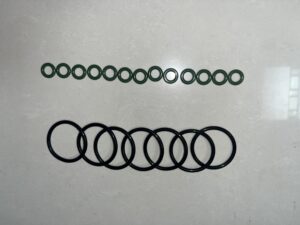Table of Contents
ToggleHow Long Do Silicone O-Rings Last?
Silicone O-rings are renowned for their durability, but their actual lifespan depends on storage conditions, operational demands, and maintenance practices. Under ideal circumstances, they can last decades, while harsh environments may reduce their service life to months. This guide explores their longevity in storage and active use, factors affecting performance, and strategies to maximize their lifespan.

Quick Answer: Typical Lifespan of Silicone O-Rings
- Storage (Unused): Unlimited shelf life when stored per SAE AS5316 standards.
- Static Applications: 10–30 years (e.g., plumbing, food-grade equipment).
- Dynamic/Harsh Conditions: 1–10 years (e.g., automotive systems, chemical exposure).
1. Shelf Life: How Long Can Silicone O-Rings Be Stored?
SAE AS5316 Compliance: “Unlimited” Shelf Life
- Silicone O-rings have no mandatory expiration date if stored in:
- Temperature: 15°C–38°C (59°F–100°F).
- Humidity: <75% relative humidity.
- Packaging: Sealed, UV-resistant bags with inert materials.
- This contrasts sharply with other elastomers like NBR (15-year shelf life) or polyurethane (5 years).
Best Practices for Storage
- Use Moisture-Proof Packaging: Avoid rubber-degrading preservatives.
- FIFO Inventory Management: Prioritize older stock to ensure traceability.
- Avoid Direct Sunlight/Ozone: Store in dark, cool environments.
2. Service Life: How Long Do They Last in Use?
Static Applications (Low Stress)
- Plumbing & HVAC Systems: Up to 30 years with minimal wear.
- Food/Medical Equipment: 10–20 years under FDA-compliant conditions.
Dynamic or Harsh Environments
- Automotive Systems: 3–7 years (coolant lines, fuel systems).
- High-Temperature Use (>150°C): 1–3 years due to thermal degradation.
- Chemical Exposure: 2–5 years in weak acids; weeks to months in fuels or strong solvents.
3. Key Factors Affecting Lifespan
A. Temperature Extremes
- Optimal Range: -55°C to +200°C.
- High Heat: Prolonged exposure >200°C causes hardening and cracking.
- Thermal Cycling: Frequent temperature swings accelerate fatigue.
B. Chemical Compatibility
- Resistant To: Water, ozone, UV light, mild detergents.
- Avoid: Fuels, oils, strong acids/alkalis, hydrocarbon solvents.
C. Mechanical Stress
- Static Seals: Minimal wear ensures decades of service.
- Dynamic Seals: High pressure (>500 psi) or frequent movement reduces lifespan to 1–2 years.
D. Installation & Maintenance
- Over-Compression: >30% deflection causes permanent deformation.
- Surface Finish: Rough mating surfaces accelerate abrasion.
- Lubrication: Silicone-compatible grease reduces friction in dynamic seals.
4. Real-World Lifespan Estimates
| Application Scenario | Expected Lifespan |
| Static, room-temperature | 10–30 years |
| Food/medical equipment | 10–20 years |
| Automotive coolant systems | 3–7 years |
| High-temperature (>150°C) | 1–3 years |
| Weak acid exposure | 2–5 years |
| Dynamic, low-pressure seals | 1–2 years |
5. How to Extend Silicone O-Ring Life
- Material Selection:
- Use fluorosilicone for chemical resistance or high-temp grades for thermal stability.
- Design Optimization:
- Limit compression to 15–30% in grooves.
- Polish mating surfaces to reduce abrasion.
- Operational Maintenance:
- Apply PFPE or silicone-compatible lubricants.
- Shield O-rings from UV, ozone, and steam.
- Regular Inspections:
- Check for cracks, swelling, or hardness changes annually.
6. When to Replace Silicone O-Rings
- Physical Damage: Cracks, cuts, or permanent flattening.
- Chemical Degradation: Swelling, discoloration, or loss of elasticity.
- Functional Failure: Leaks, increased friction, or seal slippage.
Conclusion
Silicone O-rings offer exceptional longevity in benign environments, with lifespans reaching 30 years in static applications. However, heat, chemicals, and mechanical stress can drastically shorten their service life. By adhering to SAE storage standards, selecting the right material grade, and maintaining optimal operating conditions, you can maximize their performance. Always consult manufacturer datasheets for application-specific guidance.



Leave A Comment